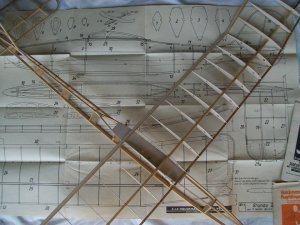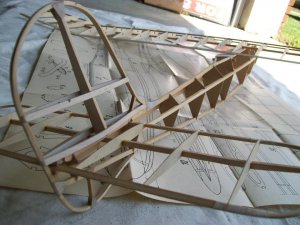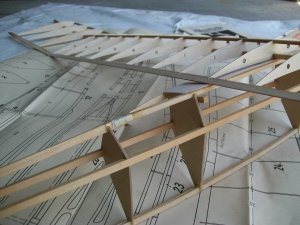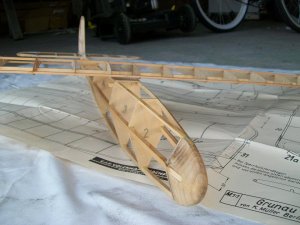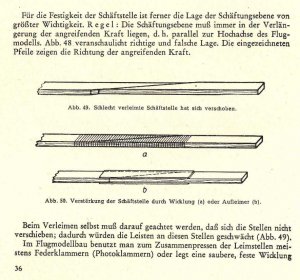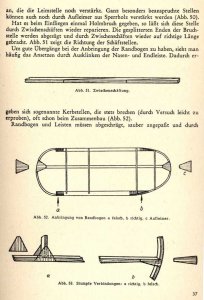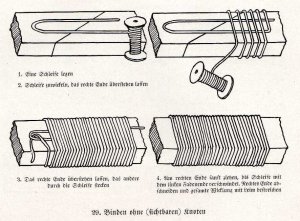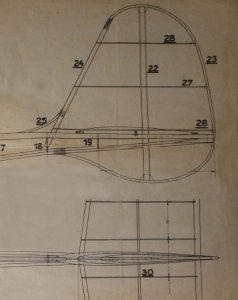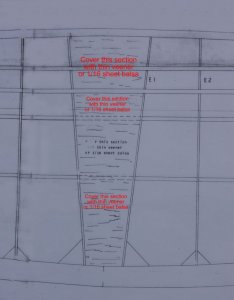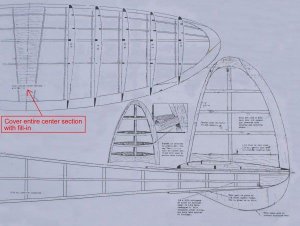Du verwendest einen veralteten Browser. Es ist möglich, dass diese oder andere Websites nicht korrekt angezeigt werden.
Du solltest ein Upgrade durchführen oder einen alternativen Browser verwenden.
Du solltest ein Upgrade durchführen oder einen alternativen Browser verwenden.
Volckmanns Grunau II - weit von Heimatland entfernt!
- Ersteller fahnenschmied
- Erstellt am
fahnenschmied
User
Oh, I could use some expert advice in interpreting what the instructions say about covering the empennage. Its rather unclear to me, and I am tempted to add a little structure to make a neater transition from hohenleitwerk to seitenleitwerk..
guckux
Vereinsmitglied, Seniorenbeauftragter
Guckux Fahnenschmied
Hatte ich hier schonmal erwähnt, daß ich Holz-Rohbaumodelle einfach liebe? Schönes Teil!
Habe ich richtig gesehen und an einigen Stellen sind Hölzer mit Faden zusammengebunden/verschnürt worden?
Und was die deutsche Sprache betrifft - kann ich Dir leider nicht bestätigen
Also: bitte mehr Bilder!
PS: Leider bin ich kein Experte
Hier sind ein paar Bilder von meiner Segelflugmodell "Grunau II". Momentan habe ich die deutsche sprache fast vergessen, aber die Fotos sagen mehr als Worten!
Hatte ich hier schonmal erwähnt, daß ich Holz-Rohbaumodelle einfach liebe? Schönes Teil!
Habe ich richtig gesehen und an einigen Stellen sind Hölzer mit Faden zusammengebunden/verschnürt worden?

Und was die deutsche Sprache betrifft - kann ich Dir leider nicht bestätigen

Also: bitte mehr Bilder!

PS: Leider bin ich kein Experte

@ Fahnenschmied
All you have to tell us with what material you want to cover the model. The plan is to provide paper or silk. Silk can be considered, as well in all directions there are little problems. If you used paper you must cover with several strips in the transition.
Noch eine Frage wie steht es mit dem Lesen in Deutsch? Wenn das Lesen keine Schwierigkeit ist könnten wir es so machen dass du die Fragen in Englisch stellst und wir antworten in Deutsch.
Gruß Heinz
Oh, I could use some expert advice in interpreting what the instructions say about covering the empennage. Its rather unclear to me, and I am tempted to add a little structure to make a neater transition from hohenleitwerk to seitenleitwerk..
All you have to tell us with what material you want to cover the model. The plan is to provide paper or silk. Silk can be considered, as well in all directions there are little problems. If you used paper you must cover with several strips in the transition.
Noch eine Frage wie steht es mit dem Lesen in Deutsch? Wenn das Lesen keine Schwierigkeit ist könnten wir es so machen dass du die Fragen in Englisch stellst und wir antworten in Deutsch.
Gruß Heinz
Kleine Abhandlung über "Wicklungen".
Bei der "Sperrholz-Kiefer- Bauweise" wurde, mehr oder weniger, bei allen Modellen Wicklungen mit Zwirn oder Hanfkordel angewendet. Bei Schäftungen und verbinden einzelner Bauteile wurde eine Wicklung zur Fixierung und Stabilisierung vorgenommen. Das war auch deshalb notwendig weil der damals verwendete "Kaltleim" bis zu 12 Stunden zum aushärten benötigte.
Im manntragenden Segelflugzeugbau (Holz) wurden diese Wicklungen auch angewendet.
Heinz
Bei der "Sperrholz-Kiefer- Bauweise" wurde, mehr oder weniger, bei allen Modellen Wicklungen mit Zwirn oder Hanfkordel angewendet. Bei Schäftungen und verbinden einzelner Bauteile wurde eine Wicklung zur Fixierung und Stabilisierung vorgenommen. Das war auch deshalb notwendig weil der damals verwendete "Kaltleim" bis zu 12 Stunden zum aushärten benötigte.
Im manntragenden Segelflugzeugbau (Holz) wurden diese Wicklungen auch angewendet.
Heinz
Anhänge
fahnenschmied
User
Guckux Fahnenschmied
Habe ich richtig gesehen und an einigen Stellen sind Hölzer mit Faden zusammengebunden/verschnürt worden?
Ja, Guckux, Du hast richtig gesehen - die Holmen sind mit echte Deutsche leinfaden umwickelt! Die Randbogen des hohenleitwerk auch...
Mehr Bilder - hoffentlich bald!
fahnenschmied
User
@ Fahnenschmied
All you have to tell us with what material you want to cover the model. The plan is to provide paper or silk. Silk can be considered, as well in all directions there are little problems. If you used paper you must cover with several strips in the transition.
Noch eine Frage wie steht es mit dem Lesen in Deutsch? Wenn das Lesen keine Schwierigkeit ist könnten wir es so machen dass du die Fragen in Englisch stellst und wir antworten in Deutsch.
Gruß Heinz
Heinz, I would love to cover this model with "Deutsches Japanpapier" , or whatever the plans call for, and "Cellon oder Cellonit", but I will probably use Silkspan and Nitrate dope...unless there is some good German covering paper available somewhere. The man who gave me the plans told me the paper he used in the late 30s seemed about the same as the Silkspan he used after moving here. Never tried silk...
I would say reading German isnt normally much of a problem, and an answer in German to any question I might have would be fine - however, I still don't quite fathom just what you are supposed to do to anchor the covering for the stabilizer, where it meets the fin...
MfG Dave
fahnenschmied
User
Kleine Abhandlung über "Wicklungen".
Bei der "Sperrholz-Kiefer- Bauweise" wurde, mehr oder weniger, bei allen Modellen Wicklungen mit Zwirn oder Hanfkordel angewendet. Bei Schäftungen und verbinden einzelner Bauteile wurde eine Wicklung zur Fixierung und Stabilisierung vorgenommen. Das war auch deshalb notwendig weil der damals verwendete "Kaltleim" bis zu 12 Stunden zum aushärten benötigte.
Im manntragenden Segelflugzeugbau (Holz) wurden diese Wicklungen auch angewendet.
Heinz
Vielen dank! Ich bin auch noch nicht sicher, "kaltleim" oder "kleber" zu benutzen. Bei meiner Wickelungen -und auch fast alles - is Kaltleim (butterfarbige), nicht Kleber (Bernsteinfarbige)....
Ich wurde gern mehr aus dieser Buch sehen!
@ Fahnenschmied
Hallo Dave, mit dem Rohbau bist du doch fast fertig für die restlichen Arbeiten kannst du Weisleim (Bindan-P, Ponal u.s.w.) nehmen.
Zum aufbringen der Bespannung mit Papier ist Tapentenleim (Wallpaper Glue) sehr gut geeignet.
Hast du etwas spezielles was ich aus dem Buch posten soll?
Gruß Heinz
P.S. Ich sehe gerade das du zwei Beiträge geschrieben hast. Mache doch bitte mal ein Bild wo das Problem mit dem Höhen- und Seitenleitwerk besteht.
"kaltleim" oder "kleber"
Hallo Dave, mit dem Rohbau bist du doch fast fertig für die restlichen Arbeiten kannst du Weisleim (Bindan-P, Ponal u.s.w.) nehmen.
Zum aufbringen der Bespannung mit Papier ist Tapentenleim (Wallpaper Glue) sehr gut geeignet.
Hast du etwas spezielles was ich aus dem Buch posten soll?
Gruß Heinz
P.S. Ich sehe gerade das du zwei Beiträge geschrieben hast. Mache doch bitte mal ein Bild wo das Problem mit dem Höhen- und Seitenleitwerk besteht.
___________________________________________________________________________________________________________________________________________________________________
Richtig zitieren!
Heinz, bitte in Zukunft für’s Zitieren die Zitierfunktionen (unten rechts, Anleitung dazu hier) verwenden!
Ein freundlicher Hinweis des Moderators!
___________________________________________________________________________________________________________________________________________________________________Heinz, bitte in Zukunft für’s Zitieren die Zitierfunktionen (unten rechts, Anleitung dazu hier) verwenden!
Ein freundlicher Hinweis des Moderators!
Zuletzt bearbeitet von einem Moderator:
Garagedweller
User
Bespannung
Bespannung
Hallo Dave!
Hab Deinen Thread mit Interesse verfolgt; bin zu dem Schluss gekommen dass Du noch keine so richtige Antwort zu Deinem Bespannungsproblem am HLW/SLW erhalten hast.
Nun ich bin da kein Experte wie so manche von den Jungs hier wenns zu solchen Sachen kommt, hätte aber einen Vorschlag wie das zu machen wär - for what its worth:
Der Raum zwischen den innersten Rippen am HLW sollte entweder mit Holz (Balsastückchen?) ausgefüllt sein, oder eine Beplankung über diese zwei Rippen angebracht werden - oben und unten! Beide Methoden sind jetzt tüftelig zum implementieren, aber mit etwas Geduld sollte dies machbar sein. Dies sollte schon vor dem Einleimen des SLWs gemacht werden; die Germanskis von damals hatten diese kleine Wichtigkeit wohl ganz übersehen. Hab hier einen Bauplan des 'Ikarus' von Leopold Scheuer, und da sieht es mir genau so aus - die Ösis haben das auch so gemacht. Häng hier ein Bild an, wo man das gleiche Problem hat.
Häng hier ein Bild an, wo man das gleiche Problem hat.
Zur Sommerzeit 1939 hat ein gewisser Joe Elgin den Bauplan für das 'Playboy' Modell gezeichnet, sodass die Eltern ihren Jungs zu Weihnachten etwas unter den Weihnachtsbaum legen konnten. Das nur so nebenbei wie es zu diesem Bauplan/Flugmodell kam. Hab hier eine Kopie eines solchen Plans. Hab den Teil zum HLW/SLW vom BP abgeknipst, und die Beschriftung für die 'fill-ins' und Beplankung lesbarer gemacht.
In einem Baubericht von Chris Jenkins bei RCGroups findet man auch ein Bild von einem Playboy Modell, gehalten von Joe Elgin selbst, wo man gut erkennen kann wie die Auflage zur Bespannung ist. Siehe Beitrag #82 im RCG Baubericht. A picture is worth a thousand words!!!
Hier der Link dazu:
http://www.rcgroups.com/forums/showthread.php?t=336766&page=6
Hoffentlich hilft Dir dieser Hinweis zu Deinem Problem.
Viel Spass und Erfolg wünscht Dir zu Deinem sehr, sehr sauber gebauten Modell - sieht aus 'wia aussem Schächtele'!
Gruss Eppo
Bespannung
Hallo Dave!
Hab Deinen Thread mit Interesse verfolgt; bin zu dem Schluss gekommen dass Du noch keine so richtige Antwort zu Deinem Bespannungsproblem am HLW/SLW erhalten hast.
Zitat von fahnenschmied
...I still don't quite fathom just what you are supposed to do to anchor the covering for the stabilizer, where it meets the fin...
Nun ich bin da kein Experte wie so manche von den Jungs hier wenns zu solchen Sachen kommt, hätte aber einen Vorschlag wie das zu machen wär - for what its worth:
Der Raum zwischen den innersten Rippen am HLW sollte entweder mit Holz (Balsastückchen?) ausgefüllt sein, oder eine Beplankung über diese zwei Rippen angebracht werden - oben und unten! Beide Methoden sind jetzt tüftelig zum implementieren, aber mit etwas Geduld sollte dies machbar sein. Dies sollte schon vor dem Einleimen des SLWs gemacht werden; die Germanskis von damals hatten diese kleine Wichtigkeit wohl ganz übersehen. Hab hier einen Bauplan des 'Ikarus' von Leopold Scheuer, und da sieht es mir genau so aus - die Ösis haben das auch so gemacht.
 Häng hier ein Bild an, wo man das gleiche Problem hat.
Häng hier ein Bild an, wo man das gleiche Problem hat.Zur Sommerzeit 1939 hat ein gewisser Joe Elgin den Bauplan für das 'Playboy' Modell gezeichnet, sodass die Eltern ihren Jungs zu Weihnachten etwas unter den Weihnachtsbaum legen konnten. Das nur so nebenbei wie es zu diesem Bauplan/Flugmodell kam. Hab hier eine Kopie eines solchen Plans. Hab den Teil zum HLW/SLW vom BP abgeknipst, und die Beschriftung für die 'fill-ins' und Beplankung lesbarer gemacht.
In einem Baubericht von Chris Jenkins bei RCGroups findet man auch ein Bild von einem Playboy Modell, gehalten von Joe Elgin selbst, wo man gut erkennen kann wie die Auflage zur Bespannung ist. Siehe Beitrag #82 im RCG Baubericht. A picture is worth a thousand words!!!

Hier der Link dazu:
http://www.rcgroups.com/forums/showthread.php?t=336766&page=6
Hoffentlich hilft Dir dieser Hinweis zu Deinem Problem.
Viel Spass und Erfolg wünscht Dir zu Deinem sehr, sehr sauber gebauten Modell - sieht aus 'wia aussem Schächtele'!

Gruss Eppo
Anhänge
fahnenschmied
User
Hallo Dave!
Hab Deinen Thread mit Interesse verfolgt; bin zu dem Schluss gekommen dass Du noch keine so richtige Antwort zu Deinem Bespannungsproblem am HLW/SLW erhalten hast.
Nun ich bin da kein Experte wie so manche von den Jungs hier wenns zu solchen Sachen kommt, hätte aber einen Vorschlag wie das zu machen wär - for what its worth:
Der Raum zwischen den innersten Rippen am HLW sollte entweder mit Holz (Balsastückchen?) ausgefüllt sein, oder eine Beplankung über diese zwei Rippen angebracht werden - oben und unten! Beide Methoden sind jetzt tüftelig zum implementieren, aber mit etwas Geduld sollte dies machbar sein. Dies sollte schon vor dem Einleimen des SLWs gemacht werden; die Germanskis von damals hatten diese kleine Wichtigkeit wohl ganz übersehen. Hab hier einen Bauplan des 'Ikarus' von Leopold Scheuer, und da sieht es mir genau so aus - die Ösis haben das auch so gemacht.Häng hier ein Bild an, wo man das gleiche Problem hat.
Zur Sommerzeit 1939 hat ein gewisser Joe Elgin den Bauplan für das 'Playboy' Modell gezeichnet, sodass die Eltern ihren Jungs zu Weihnachten etwas unter den Weihnachtsbaum legen konnten. Das nur so nebenbei wie es zu diesem Bauplan/Flugmodell kam. Hab hier eine Kopie eines solchen Plans. Hab den Teil zum HLW/SLW vom BP abgeknipst, und die Beschriftung für die 'fill-ins' und Beplankung lesbarer gemacht.
In einem Baubericht von Chris Jenkins bei RCGroups findet man auch ein Bild von einem Playboy Modell, gehalten von Joe Elgin selbst, wo man gut erkennen kann wie die Auflage zur Bespannung ist. Siehe Beitrag #82 im RCG Baubericht. A picture is worth a thousand words!!!
Hier der Link dazu:
http://www.rcgroups.com/forums/showthread.php?t=336766&page=6
Hoffentlich hilft Dir dieser Hinweis zu Deinem Problem.
Viel Spass und Erfolg wünscht Dir zu Deinem sehr, sehr sauber gebauten Modell - sieht aus 'wia aussem Schächtele'!
Gruss Eppo
Many thanks, Eppo - please forgive my English reply, as I have a very short time to answer from this computor! You have perfectly understood my problem in covering, and I have indeed thought of spanning the two inner ribs with some very thin plywood. Yes, better before I attached it, but I was trying to follow the instructions - which I was a little suspicious of.
I dont want to use balsa, as it is my understanding that this was little used in German modeling in the late 30ies and early 40ies. I wish to build it the same as it would have been, but some touches, like using antique sequin-pins for the nails, were just because that was at hand..
Thank you as well for the very kind compliment, and many thanks to answering the biggest question I had about covering this model!!
MfG Dave
fahnenschmied
User
@ Fahnenschmied
Hallo Dave, mit dem Rohbau bist du doch fast fertig für die restlichen Arbeiten kannst du Weisleim (Bindan-P, Ponal u.s.w.) nehmen.
Zum aufbringen der Bespannung mit Papier ist Tapentenleim (Wallpaper Glue) sehr gut geeignet.
Hast du etwas spezielles was ich aus dem Buch posten soll?
Gruß Heinz
.
[center
Heinz - leider auf Englisch - ich hab es eilig!! Bindan and Ponal is not to be had here, but the cold wood glue I have used is very similar, I think. I would not have thought to use Tapetenleim in covering. I thought of using Ambroid and dope, to stick it on, but after reading some of my late 30s books I thought perhaps using the same wood glue, especially for the undercambered wings, would be fine. I might see if our American wall paper glue holds promise!
From this book - anything about how to soak your wood for bending (It just said "sehr anfeuchten" in the directions), and also, just how to treat glue joints... In old American practice, you put a bead of glue around each crossing of wood, two or three times. But this was with balsa and quick drying "Kleber". I have done the same with slower drying Kaltleim. Also, anything that might be there on bending bamboo wingtips. I can do that, as you see from the hohenleitwerk, but I am just curious...
Many thanks!
Gruss, Dave
fahnenschmied
User
Another question or two here, as I am so happy to find anyone who knowing anything at all about these sorts of things!
First, on my model, the wing-saddle and the spars which hold the rubber bands are glued as well as pinned into place. However, the plywood underneath the wing is only held by glue to some 40mm of spar. (as well as the rather weak trailing edge). In American practice from this time, the rubber bands cross front to back over the wing itself, and this arrangement would be fine. But here, the bands cross from side to side, only on the plywood bit glued to the wing. Gliding down a hill, no problem, but launching it from the kite string and rubber strip? I just dont want to see the wing rip off on the first flight!
Second, on the very small and grainy photos on the instructions, it shows the lower fuselage in a color. Also, the nose and a band on the rear fuselage look dark. I know finishing it in just plain white would be "correct" as well...just curious as to what would be most typical of the time!
Would this colored area be from colored paper? Could it be the lower fuselage had an extra layer of colored paper as a protection for landing? Any suggestions as to what colors for the belly and bands? In one of my American books from 1937, it is suggested that some color be applied, so you can see it in the sky, and the suggested colors were red, blue, and yellow. There may have been a chart with how far a test model could be seen by colors, or some other somewhat scientific thing. I had been looking for color photos of model flying in Germany from the old days without much luck.
Oh, every time I see "I am no expert, but" - I get excellent advice and help. I am looking forward to more non-expert advice! Sorry for the post in English, but I have not enough time at the computer to compose it in German (Which might take me all day...) but I am quite happy to see your answers in German!!
Gruss,
Dave
First, on my model, the wing-saddle and the spars which hold the rubber bands are glued as well as pinned into place. However, the plywood underneath the wing is only held by glue to some 40mm of spar. (as well as the rather weak trailing edge). In American practice from this time, the rubber bands cross front to back over the wing itself, and this arrangement would be fine. But here, the bands cross from side to side, only on the plywood bit glued to the wing. Gliding down a hill, no problem, but launching it from the kite string and rubber strip? I just dont want to see the wing rip off on the first flight!
Second, on the very small and grainy photos on the instructions, it shows the lower fuselage in a color. Also, the nose and a band on the rear fuselage look dark. I know finishing it in just plain white would be "correct" as well...just curious as to what would be most typical of the time!
Would this colored area be from colored paper? Could it be the lower fuselage had an extra layer of colored paper as a protection for landing? Any suggestions as to what colors for the belly and bands? In one of my American books from 1937, it is suggested that some color be applied, so you can see it in the sky, and the suggested colors were red, blue, and yellow. There may have been a chart with how far a test model could be seen by colors, or some other somewhat scientific thing. I had been looking for color photos of model flying in Germany from the old days without much luck.
Oh, every time I see "I am no expert, but" - I get excellent advice and help. I am looking forward to more non-expert advice! Sorry for the post in English, but I have not enough time at the computer to compose it in German (Which might take me all day...) but I am quite happy to see your answers in German!!
Gruss,
Dave
fahnenschmied
User
Can anyone suggest a good covering paper? It seem Graupner still has paper - any suggestions on what weight or type? And Heinz, any thing from your old book about covering would be interesting to see...
Thanks!
Thanks!
A very good substitution for paper ist Polyester "Bespannvlies".
Its the same as coverall but much thinner for smaller Modells. Weight: 25g/m^2
Look here for Infos. sorry is german.
http://lamaflieger.jimdo.com/bezugsquellen/bespannvlies/
I put it on my L-Spatz 55 4m-span and my Topsy.
Pictures here:
http://lamaflieger.jimdo.com/projekte/l-spatz-55-4m/
https://picasaweb.google.com/105628163364370692459/TopsyReplika?authkey=Gv1sRgCJGAjpeL-pCTxQE
With "Spannlack" you can gloo it. And with an hot air gun you can shrink it. After shrinking you coat it with Spannlack.
it looks like paper , it feels like paper, but it is very strong.
best regards
Christoph
Its the same as coverall but much thinner for smaller Modells. Weight: 25g/m^2
Look here for Infos. sorry is german.
http://lamaflieger.jimdo.com/bezugsquellen/bespannvlies/
I put it on my L-Spatz 55 4m-span and my Topsy.
Pictures here:
http://lamaflieger.jimdo.com/projekte/l-spatz-55-4m/
https://picasaweb.google.com/105628163364370692459/TopsyReplika?authkey=Gv1sRgCJGAjpeL-pCTxQE
With "Spannlack" you can gloo it. And with an hot air gun you can shrink it. After shrinking you coat it with Spannlack.
it looks like paper , it feels like paper, but it is very strong.
best regards
Christoph
Garagedweller
User
Japanese Tissue Paper
Japanese Tissue Paper
Hello Dave!
The previous post by ratzfatz is a good one, suggesting to use "Polyester Bespannvlies". As a matter of fact, there is also a thread right before yours by RCN member Tramp, where he shows off his HAST model, covered with that Polyester Vlies material. Tramp also gives a link to his building thread in a Dutch Modelbuilding forum, where he is a member and goes under the nickname of Ariel.
Johannes shows a lot of pictures in his building thread about covering with Vlies - the ones of special interest are 'hast169' to 'hast193'.
Also, this morning when I woke up I had a brainstorm - GOOGLE is my friend!!!
Found a couple seemingly good sources for Japanese tissue paper in the US. Vlies may be a very good material, but if you want to cover your model with paper like it was done in the '40s, '50s and sixties, I am with you. Here are the links to those two US sources:
http://www.easybuiltmodels.com/ebl.htm
http://www.lcipaper.com/japanese-paper.html
There may be more sources than these two; I stopped here as I thought this is a good start. As well, there could be local stores in your area selling giftwrap paper along with Japanese tissue paper.
And, no doubt GOOGLE will be at your service anytime you need it.
Hope this helps you on your way to get your model completed, and in the air.
With best regards
Eppo
Japanese Tissue Paper
Hello Dave!
Can anyone suggest a good covering paper? It seem Graupner still has paper - any suggestions on what weight or type? And Heinz, any thing from your old book about covering would be interesting to see...
Thanks!
The previous post by ratzfatz is a good one, suggesting to use "Polyester Bespannvlies". As a matter of fact, there is also a thread right before yours by RCN member Tramp, where he shows off his HAST model, covered with that Polyester Vlies material. Tramp also gives a link to his building thread in a Dutch Modelbuilding forum, where he is a member and goes under the nickname of Ariel.
Zitat von TRAMP
Wenn du intersse hast kannst dir mal denn Baubericht anschauen.
Ist auf Holländisch aber es sind genug Fotos reingestellt.
http://www.modelbouwforum.nl/forums/...segler-38.html
Johannes
Johannes shows a lot of pictures in his building thread about covering with Vlies - the ones of special interest are 'hast169' to 'hast193'.
Also, this morning when I woke up I had a brainstorm - GOOGLE is my friend!!!

Found a couple seemingly good sources for Japanese tissue paper in the US. Vlies may be a very good material, but if you want to cover your model with paper like it was done in the '40s, '50s and sixties, I am with you. Here are the links to those two US sources:
http://www.easybuiltmodels.com/ebl.htm
http://www.lcipaper.com/japanese-paper.html
There may be more sources than these two; I stopped here as I thought this is a good start. As well, there could be local stores in your area selling giftwrap paper along with Japanese tissue paper.
And, no doubt GOOGLE will be at your service anytime you need it.

Hope this helps you on your way to get your model completed, and in the air.
With best regards
Eppo
fahnenschmied
User
A very good substitution for paper ist Polyester "Bespannvlies".
Its the same as coverall but much thinner for smaller Modells. Weight: 25g/m^2
Look here for Infos. sorry is german.
http://lamaflieger.jimdo.com/bezugsquellen/bespannvlies/
I put it on my L-Spatz 55 4m-span and my Topsy.
Pictures here:
http://lamaflieger.jimdo.com/projekte/l-spatz-55-4m/
https://picasaweb.google.com/105628163364370692459/TopsyReplika?authkey=Gv1sRgCJGAjpeL-pCTxQE
With "Spannlack" you can gloo it. And with an hot air gun you can shrink it. After shrinking you coat it with Spannlack.
it looks like paper , it feels like paper, but it is very strong.
best regards
Christoph
Christoph,
I spent some time looking at the photos of your L-Spatz 55, quite impressive! While this Bespannvlies seem to be interesting material, I want to keep this particular model as true to the 30er time as I can. I was mostly curious as to whether there was a German made equivalent to our Silkspan paper.
fahnenschmied
User
Hello Dave!
Found a couple seemingly good sources for Japanese tissue paper in the US. Vlies may be a very good material, but if you want to cover your model with paper like it was done in the '40s, '50s and sixties, I am with you. Here are the links to those two US sources:
http://www.easybuiltmodels.com/ebl.htm
http://www.lcipaper.com/japanese-paper.html
There may be more sources than these two; I stopped here as I thought this is a good start. As well, there could be local stores in your area selling giftwrap paper along with Japanese tissue paper.
And, no doubt GOOGLE will be at your service anytime you need it.
Hope this helps you on your way to get your model completed, and in the air.
With best regards
Eppo
Eppo, many thanks - I may look into this but the Japanese tissue I have used is rather light, and I have only used it on rubber powered models of some 60cm span or so. I am not sure if the sparcer construction of more unsupported surface will work with the Japanese tissue - and the gift wrapping stuff I get here is utterly worthless for covering. Well, back to work...
Dave
fahnenschmied
User
I happened to take my uncompleted model with me to a local airshow - and I realized that the two Luftwaffe pilots who were there probably built models like mine and could answer some questions. Both complimented my work - "Its harder to do than it looks", one said - and they did approve of my planking over the ribs of the stabilizer, and one said I should put bits of thin ply around the pegs for the rubber bands. I have done so, and now I am ready to cover it.
On my plans, there is a photo which shows a model with a darker covering on the bottom of the fuselage. Was it common to use a layer of colored tissue for this, to make a double covering? I forgot to ask this of the old guys...
Well, back to covering the fuselage...
On my plans, there is a photo which shows a model with a darker covering on the bottom of the fuselage. Was it common to use a layer of colored tissue for this, to make a double covering? I forgot to ask this of the old guys...
Well, back to covering the fuselage...
Ähnliche Themen
- Antworten
- 2
- Aufrufe
- 809

